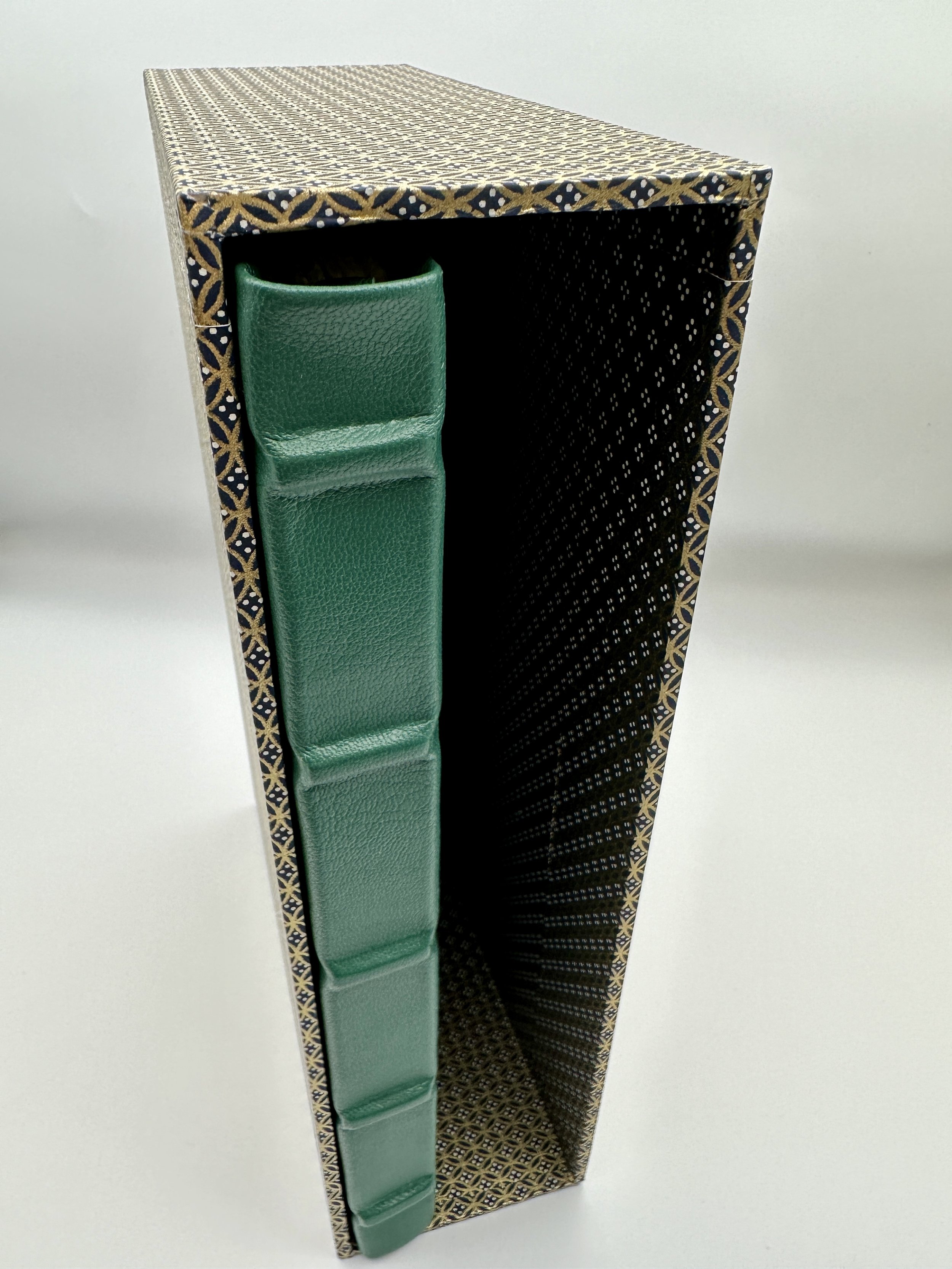Susan's Wedding
N.B. This is commissioned work and nfs.
1) This journal/sketchbook is made from 120 gsm Arches hand-laid, all cotton rag paper from France. It is sewn with Irish linen in the linked stitch pattern that was developed by the ancient Copts. This stitch allows the book to lay open at any page.
Its endbands are green and yellow cotton, and its bookmark is goatskin. The spine is covered in Alran French goatskin that was processed at Rocky Mountain Leather Supply in Utah, and its boards are wrapped in paper that was hand silk-screened in Japan, in a factory where kimono silks are decorated.
The talisman in this book is a 19th Century French marriage medallion, bearing the inscription: Mariage/Chretien (Christian Marriage) and signed by Pengret F.
2) This album is made from 120 gsm Arches hand-laid, all cotton rag paper from France. It is sewn with Irish linen in the linked stitch pattern that was developed by the ancient Copts. This stitch allows the book to lay open at any page.
Treasure binding began with monks in the 6th Century who would encrust volumes with jewels. During the Renaissance, there was a resurgence in treasure binding. This is a contemporary revival of the treasure binding in which a lucky charm has been embedded in the cover of this book.
The talisman in this book is a 19th Century French marriage medallion, bearing the inscription: Fidelite/Bonheur (Loyalty/Happiness) and signed by Petit F.
3) This custom, coordinating slipcase protects this pair of matched books when they are shelved. It is a gift from the binder to thank Susan for her patience.
N.B. This is commissioned work and nfs.
1) This journal/sketchbook is made from 120 gsm Arches hand-laid, all cotton rag paper from France. It is sewn with Irish linen in the linked stitch pattern that was developed by the ancient Copts. This stitch allows the book to lay open at any page.
Its endbands are green and yellow cotton, and its bookmark is goatskin. The spine is covered in Alran French goatskin that was processed at Rocky Mountain Leather Supply in Utah, and its boards are wrapped in paper that was hand silk-screened in Japan, in a factory where kimono silks are decorated.
The talisman in this book is a 19th Century French marriage medallion, bearing the inscription: Mariage/Chretien (Christian Marriage) and signed by Pengret F.
2) This album is made from 120 gsm Arches hand-laid, all cotton rag paper from France. It is sewn with Irish linen in the linked stitch pattern that was developed by the ancient Copts. This stitch allows the book to lay open at any page.
Treasure binding began with monks in the 6th Century who would encrust volumes with jewels. During the Renaissance, there was a resurgence in treasure binding. This is a contemporary revival of the treasure binding in which a lucky charm has been embedded in the cover of this book.
The talisman in this book is a 19th Century French marriage medallion, bearing the inscription: Fidelite/Bonheur (Loyalty/Happiness) and signed by Petit F.
3) This custom, coordinating slipcase protects this pair of matched books when they are shelved. It is a gift from the binder to thank Susan for her patience.
N.B. This is commissioned work and nfs.
1) This journal/sketchbook is made from 120 gsm Arches hand-laid, all cotton rag paper from France. It is sewn with Irish linen in the linked stitch pattern that was developed by the ancient Copts. This stitch allows the book to lay open at any page.
Its endbands are green and yellow cotton, and its bookmark is goatskin. The spine is covered in Alran French goatskin that was processed at Rocky Mountain Leather Supply in Utah, and its boards are wrapped in paper that was hand silk-screened in Japan, in a factory where kimono silks are decorated.
The talisman in this book is a 19th Century French marriage medallion, bearing the inscription: Mariage/Chretien (Christian Marriage) and signed by Pengret F.
2) This album is made from 120 gsm Arches hand-laid, all cotton rag paper from France. It is sewn with Irish linen in the linked stitch pattern that was developed by the ancient Copts. This stitch allows the book to lay open at any page.
Treasure binding began with monks in the 6th Century who would encrust volumes with jewels. During the Renaissance, there was a resurgence in treasure binding. This is a contemporary revival of the treasure binding in which a lucky charm has been embedded in the cover of this book.
The talisman in this book is a 19th Century French marriage medallion, bearing the inscription: Fidelite/Bonheur (Loyalty/Happiness) and signed by Petit F.
3) This custom, coordinating slipcase protects this pair of matched books when they are shelved. It is a gift from the binder to thank Susan for her patience.





























